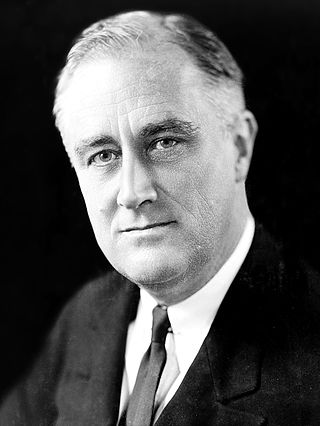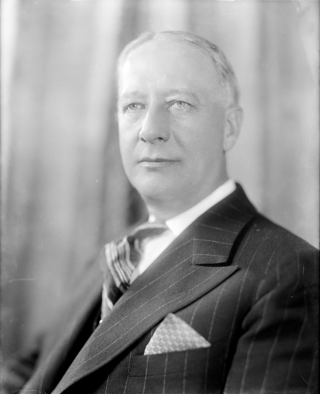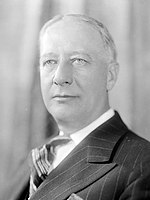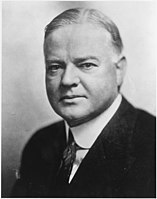
The 1928 United States presidential election was the 36th quadrennial presidential election, held on Tuesday, November 6, 1928. Republican former Secretary of Commerce Herbert Hoover defeated the Democratic nominee, Governor Al Smith of New York. After President Calvin Coolidge declined to seek reelection, Hoover emerged as his party's frontrunner. As Hoover's party opponents failed to unite around a candidate, Hoover received a large majority of the vote at the 1928 Republican National Convention. The strong state of the economy discouraged some Democrats from running, and Smith was nominated on the first ballot of the 1928 Democratic National Convention. Hoover and Smith had been widely known as potential presidential candidates long before the 1928 campaign, and both were generally regarded as outstanding leaders. Both were newcomers to the presidential race and presented in their person and record an appeal of unknown potency to the electorate. Both faced serious discontent within their respective parties' membership, and both lacked the wholehearted support of their parties' organization.

The 1932 United States presidential election was the 37th quadrennial presidential election, held on Tuesday, November 8, 1932. The election took place against the backdrop of the Great Depression. The incumbent Republican President Herbert Hoover was defeated in a landslide by Democrat Franklin D. Roosevelt, the governor of New York and the vice presidential nominee of the 1920 presidential election. Roosevelt was the first Democrat in 80 years to simultaneously win an outright majority of the electoral college and popular vote, a feat last accomplished by Franklin Pierce in 1852, as well as the first Democrat in 56 years to win a majority of the popular vote, which was last achieved by Samuel J. Tilden in 1876. Roosevelt was the last sitting governor to be elected president until Bill Clinton in 1992. Hoover became the first incumbent president to lose an election to another term since William Howard Taft in 1912, the last to do so until Gerald Ford lost 44 years later, and the last elected incumbent president to do so until Jimmy Carter lost 48 years later. The election marked the effective end of the Fourth Party System, which had been dominated by Republicans. It was the first time since 1916 that a Democrat was elected president.

Joseph Taylor Robinson was an American politician who served as United States Senator from Arkansas from 1913 to 1937, serving for four years as Senate Majority Leader and ten as Minority Leader. A member of the Democratic Party, he previously served as the state's 23rd governor, and was also the Democratic vice presidential nominee in the 1928 presidential election.

The 1928 United States presidential election in Virginia took place on November 6, 1928. Voters chose 12 representatives, or electors to the Electoral College, who voted for president and vice president.

The 1928 United States presidential election in Alabama took place on November 6, 1928, as part of the 1928 United States presidential election, which was held throughout all contemporary forty-eight states. Voters chose twelve representatives, or electors to the Electoral College, who voted for president and vice president. This was the last election in which Alabama had twelve electoral votes: the Great Migration caused the state to lose congressional districts after the 1930 Census produced the first Congressional redistricting since 1911.

The 1936 United States presidential election in Florida was held on November 8, 1936. Florida voters chose seven electors, or representatives to the Electoral College, who voted for president and vice president.

The 1928 United States presidential election in Florida was held on November 6, 1928, as part of the 1928 United States presidential election held throughout all contemporary forty-eight states. Florida voters chose six electors, or representatives to the Electoral College, who voted for president and vice president.

Al Smith, Governor of New York, was a candidate for President of the United States in the 1928 election. His run was notable in that he was the first Catholic nominee of a major party, he opposed Prohibition, and he enjoyed broad appeal among women, who had won the right of suffrage in 1920.

The 1928 United States presidential election in Texas took place on November 6, 1928, as part of the 1928 United States presidential election which was held throughout all contemporary forty-eight states. Voters chose 20 representatives, or electors, to the Electoral College, who voted for president and vice president.

The 1932 United States presidential election in Georgia took place on November 8, 1932, as part of the 1932 United States presidential election. Voters chose 12 representatives, or electors, to the Electoral College, who voted for president and vice president.

The 1928 United States presidential election in Georgia took place on November 6, 1928, as part of the wider United States presidential election. Voters chose 14 representatives, or electors, to the Electoral College, who voted for president and vice president.

The 1936 United States presidential election in Arkansas took place on November 3, 1936, as part of the 1936 United States presidential election. State voters chose nine representatives, or electors, to the Electoral College, who voted for president and vice president.

The 1928 United States presidential election in North Carolina was held on November 6, 1928. North Carolina voters chose twelve electors to the Electoral College, who voted for president and vice president.

The 1928 United States presidential election in Indiana took place on November 6, 1928, as part of the 1928 United States presidential election which was held throughout all contemporary 48 states. Voters chose 15 representatives, or electors to the Electoral College, who voted for president and vice president.

The 1928 United States presidential election in Oregon took place on November 6, 1928, as part of the 1928 United States presidential election. Voters chose five representatives, or electors, to the Electoral College, who voted for president and vice president.

The 1928 United States presidential election in Tennessee took place on November 6, 1928, as part of the 1928 United States presidential election. Tennessee voters chose 12 representatives, or electors, to the Electoral College, who voted for president and vice president.

The 1928 United States presidential election in Oklahoma took place on November 6, 1928, as part of the 1928 United States presidential election which was held throughout all contemporary 48 states. Voters chose ten representatives, or electors to the Electoral College, who voted for president and vice president. In its early years, Oklahoma was a “Solid South” state whose founding fathers like "Alfalfa Bill" Murray and Charles N. Haskell had disfranchised most of its black population via literacy tests and grandfather clauses, the latter of which would be declared unconstitutional in Guinn v. United States. In 1920 this “Solid South” state, nonetheless, joined the Republican landslide of Warren G. Harding, electing a GOP senator and five congressmen, but in 1922 the Democratic Party returned to their typical ascendancy as the state GOP became heatedly divided amongst themselves.

Republican candidate Herbert Hoover won the state of Illinois in the 1928 United States presidential election, and would emerge victorious from the overall election. State voters chose 29 representatives, or electors, to the Electoral College, who voted for president and vice president.

The 1928 United States presidential election in Kentucky took place on November 6, 1928, as part of the 1928 United States presidential election. Voters chose 13 representatives, or electors to the Electoral College, who voted for president and vice president.

The 1928 United States presidential election in Louisiana took place on November 6, 1928, as part of the wider United States presidential election. Voters chose ten representatives, or electors, to the Electoral College, who voted for president and vice president.























